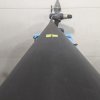DavidDeWitt
Builder and paddler
Looks great but there is really no need for fill coats on the inside of a hull (or deck). All a fill coat really does is add weight.
Sometimes I've had pinholes in the first layer when the glass is applied, so a fill coat helps with that. If you do a good job of removing all the excess epoxy in the glass layer (read Ted Moores on technique for that) , it leaves a pretty rough surface which is a magnet for dirt (and water), so a thin fill coat can be an advantage even in the compartments. Not glassy even and smooth, just smoother. In the cockpit I usually put an extra layer of glass or Dynel where my heels will land, as well as tie-downs on the sole (hull) for pump, etc.. so those areas get extra epoxy then.Looks great but there is really no need for fill coats on the inside of a hull (or deck). All a fill coat really does is add weight.
Your plan with the strips is 'standard' with strip-built boats, and should work well. The weight of the cedar is so little that I wouldn't bother planing it down - it will only save a few ounces. I know, " a bit here, a bit there.." and I've never had a lot of luck building a very lightweight boat.What do you suggest for light weight bulkheads?
















